Painting walls and ceiling is a popular finish type. To make it, you need to stick on the surface wallpaper specially designed for further painting. This article will tell you how the painting of the wallpaper of water-emulsion paint is carried out.
How to apply the first layer
In the process of staining the most difficult moment for beginners, which will be engaged in this case with their own hands, is the application of the primary layer. From how qualitatively the first layer will be applied, the final result and the final type of walls or the ceiling will depend.
But before considering the features of applying water paint with their own hands, it should be noted that the base for paint should be special. For these purposes, such a painting wallpaper will be suitable:
- vinyl;
- fliseline;
- Gymelomes.
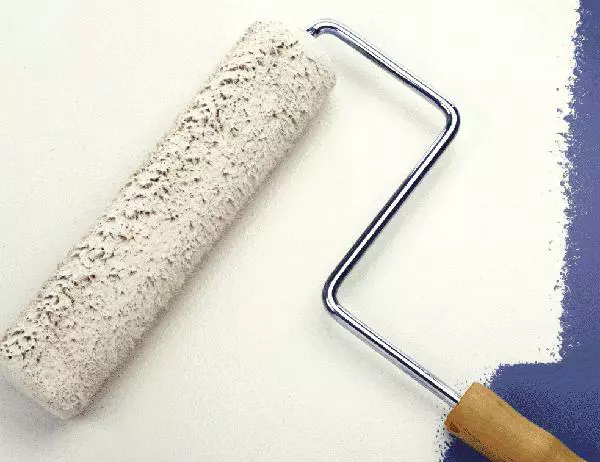
Some people are wondering "Is it possible to paint liquid wallpaper." This question arose from the specifics that liquid wallpapers have. After applying to the surface, liquid wallpaper allows you to create a pleasant to the touch layer of finishing. But it will be lost, if liquid wallpaper is painted. Therefore, if you still decided to paint liquid wallpapers, weigh everything in and against. Experts recommend using as a basis for paint not liquid wallpaper, but the aforementioned materials.
Usually paint on such a basis as wallpaper (special or liquid), applied in several layers. Here, the main thing is to properly apply the first layer, and the rest will already go to bed without problems. Collecting paint technology in several layers allows you to get certain patterns and pictures on the ceiling or walls. Moreover, if you correctly master this technology, you can achieve an unusual result, not even by the artist.
To apply the first layer of paint, you should conduct special training. It implies the stuffing of all places to which paint should not fall, a special painting scotch. In addition, on the ceiling or walls you need to clean the entire working surface from dust and dirt. For these purposes, use moisturized rags.
Article on the topic: Facade cassettes are simple and tasteful
Also before painting, it is necessary to purchase a waterfront paint with a pigment. It is necessary to calculate the flow of painting material by 1 m2 on the surface. This is necessary in order to immediately prepare the desired volume of the mixture, and so that it has the same color. Only so you can achieve a uniform shade throughout the surface of the ceiling and walls.

After the preparation was completed, you can proceed to apply the primary layer with your own hands. In this situation, the algorithm of the proceedings has the following form:
- Initially, a bit of the dye should be applied to the wall or ceiling. This plot should be the least noticeable. So you can appreciate the final result and the correctness of the selected proportions used for the preparation of the dye.
- If the result made you, painting the rest of the sections on the ceiling or walls should be carried out with a soft roller.
- The first layer is applied in one direction, and all subsequent - in the other.
After that, when the first thin layer of paint was applied to the prepared surface, he needs to give time to completely dry.
Remember that after staining the walls or the ceiling of the water-based paint on them, it will be quite problematic to stick the wobbly canvas. Therefore, if the application is planned, the place of application before painting needs to be closed with painting tape.
Pictures and decoration
After the first layer of paint is dry, you can proceed to decorating the ceiling or walls by creating certain applications, ornaments and drawings on their surface.
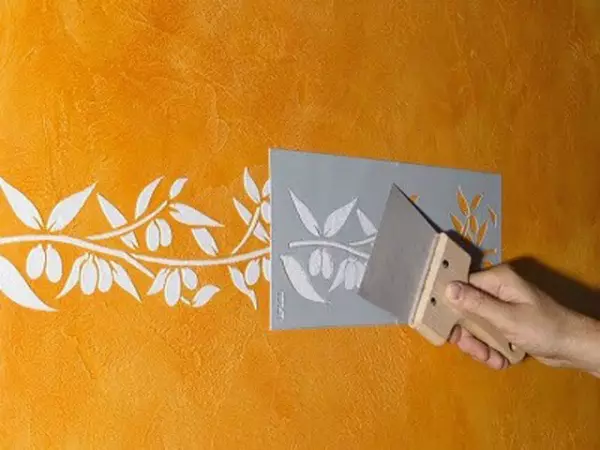
This stage should be planned even before the start of repair and buying wallpaper. After all, today, such a finish has an extensive product range, differing in texture, patterns and other characteristics.
When creating drawings with different types of paint, you can use a hard roller and wallpaper with a pronounced relief. Thus, with your own hands, you can paint the wallpaper of water-level paint of another color and get a beautiful and unusual drawing. In addition, to obtain certain artistic effects, you can use the following tools:
- brushes of different sizes;
- stencils;
- cotton swabs.
Article on the topic: Types of furnace finches with their own hands in a private house
Thanks to such tools, a person will be able to qualitatively create their own hands even a complex floral ornament.
Decor and drawings are applied with dyes of other colors that contrast with the primary layer. It is desirable that the dye chosen in this situation possessed certain properties (for example, moisture resistance, mechanical resistance, etc.). For these purposes, there are a wide variety of special artistic formulations. But their cost is high enough. Therefore, usually, they are used by professionals who possess the necessary skills and knowledge.
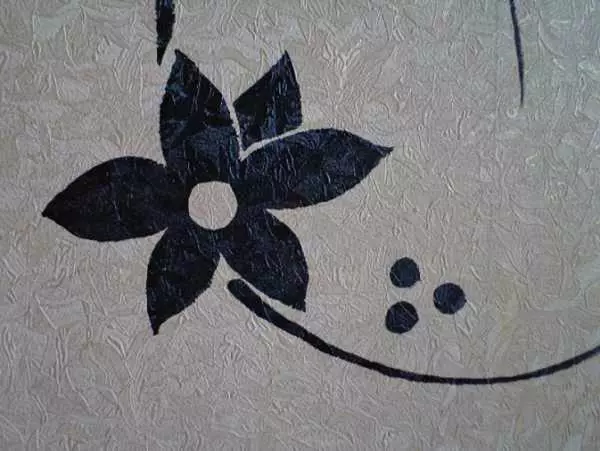
If the paint does not have additional properties, after drying it for a longer service life, the surface of the walls and the ceiling can be covered with varnish.
The key to the successful application of the decor with water-level paint is correctly selected materials that have compatible components. Using such materials, even a beginner can achieve an excellent result and high quality work done by their own works.
What to choose paint
Choosing paint for wallpapers remember that it should have a water or alkyd base. At the same time, many people prefer precisely with water-emulsion dyes. For example, phlizelin canvas are painted only by such dyes.Before deciding on the final kind of paint, paint a small piece of finishing and see how it will look. This is due to the fact that different compositions have varying degrees of shelterness, which can lead to unequal applying the dye to the base. So you can choose the most optimal option for your finishing.
The waterproof paint is several species, but they are all suitable for applying wallpaper.
Preparation of materials and surface
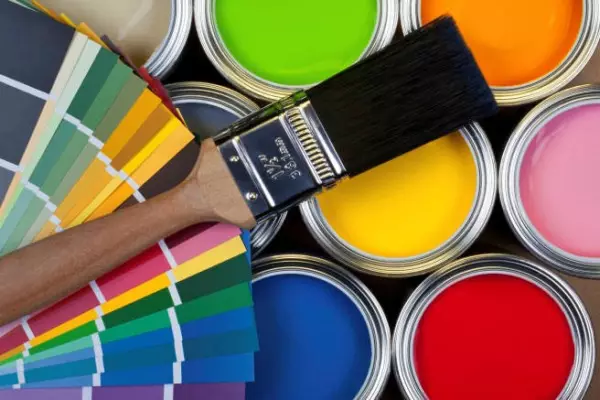
Some specialists at the preparation stage are advised on the canvas to put primer to ensure the best paint distribution over the finishing surface and preventing the formation of spots. Typically, paint stains appear due to uneven impregnation of the surface of the finish. But in this situation, when using special wallpapers and water-level paint, the use of primer is not a prerequisite. In addition, the finish itself has already high adhesion, which is not needed additionally.
Article on the topic: Frame from the plinth, with their own hands from foam
It is also necessary to carry out the following manipulations:
- de-energize the room to prevent short circuit and accidents;
- The temperature regime of the room must comply with the requirements of the dye applying technology;
- Close all windows and doors to prevent the risk of drafts (this will make it possible to achieve uniform drying of painted surfaces);
- Shipping floor, doors and windows by observing material.
In addition, you need the following materials:
- Different types of rollers for applying the primary layer and patterns;
- Tassels;
- tray;
- Malyary Scotch;
- ladder.
It will not be superfluous in the work of protective clothing (gloves, caps, glasses).
Phased process
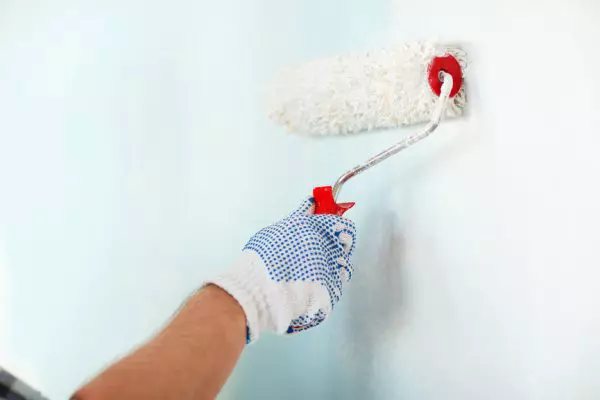
The application of the water-free dye on the prepared surface of the wallpaper is no different from painting, for example, fence. The main thing to know and comply with the following provisions:
- First, paint the corners with a brush. At the same time, it is necessary to evenly distribute the paint in the corner, avoiding its oversupply. To do this, it is distributed over the surface of the walls near the angle.
- The first layer fall horizontally. In this case, the approach to the previous band should be 5-10 cm. This method is applicable to two-layer staining.
- With a three-layer scrolling, the first layer is applied vertically. The last staining is carried out on top. The edge of the roller, the vertical pass should not coincide with the joint of the canvas.
As we see, the application of the water-level paint is a rather simple process. The main thing in this situation to adhere to the above provisions and the end result will be excellent.
Video "Wallpapers for a climbing water-free"
From this short video you will learn which canvas can be rolled by water-emulsion and that you need it.
